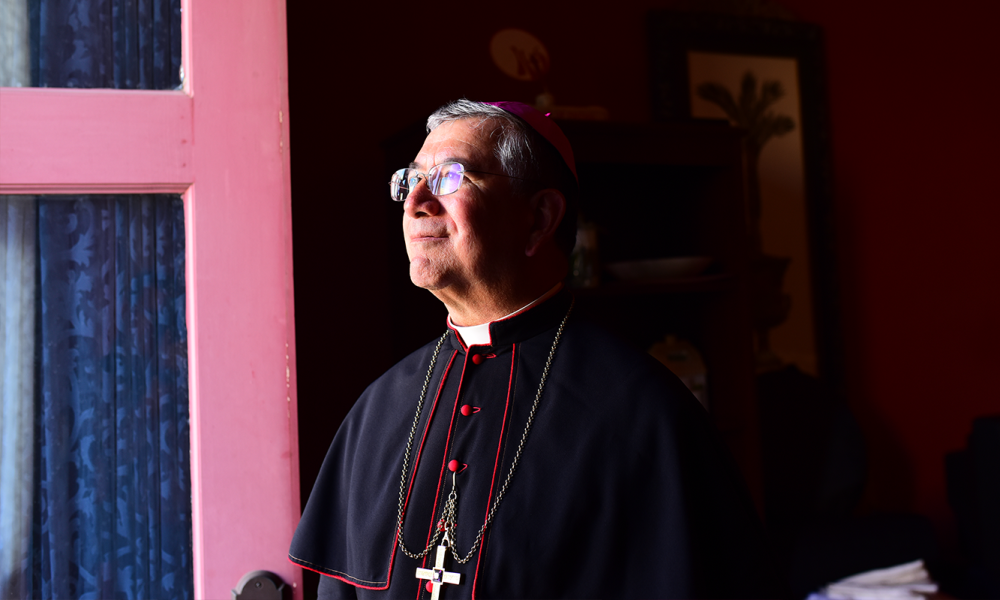
Two Languages, One Message
Bishop James Tomaya of the Diocese of Laredo, Texas is one of the Church's leaders in evangelization for Spanish-speakers. In this CE exclusive interview, he explains the importance of reaching out to people in their native language.
CE: What are the most challenging issues facing evangelization for you and for our Church in the U.S.?
+JT: I see the greatest challenge in evangelization—both in my diocese and throughout the Church—as effective faith formation for adults, especially parents and guardians. Parents are entrusted with God’s children, and must share their knowledge and understanding of the Catholic faith with their families. Sharing the faith is more than having answers to catechetical questions; it is living a life that follows Christ’s example. My diocese along the border of Mexico is heavily Hispanic. The majority of the people are baptized Catholic. They learned the teachings of God in their homes by praying as a family before an image of Christ on the cross. Devout and loyal to the Catholic faith, many Hispanics are not fully educated in the catechism. The challenge for the Church throughout the world is to reach out, particularly to parents, with evangelization programs designed to strengthen their knowledge of the Church’s teachings, while inviting them to enter into an active relationship with God within the Church community.
The Diocese of Laredo was erected in the Jubilee Year 2000. As I visited the people of the diocese, it became obvious to me one of the chief ministries I wished to provide would be the ministry of religious education for adults. In every parish I visited, I listened to the people who implored me, “Teach us about our faith so we may become strong in our knowledge of Christ’s teachings and impart this information to our children.” I am reminded of the evangelization effort of the apostle Philip in the Acts of the Apostles, as he approaches the Ethiopian eunuch reading the Scriptures. When asked by Philip if he understood what he read, the eunuch responded, “How can I? There is no one to explain it to me.” As teacher of the faith in the Diocese of Laredo and successor of the apostles, I wish to continue the teaching and evangelizing ministry that Philip and all the apostles conducted when Christ commissioned them to go forth and baptize.
CE: How important is your publication to your communications and evangelization efforts?
+JT: La Fe, the magazine of the Catholic Diocese of Laredo, plays a vital role in our communication and evangelization efforts. During a period beginning in October 2010 and concluding in July 2011, we launched an initiative to determine a mutually shared vision and mission in our diocese. When the faithful were asked, “What does the diocese do well?” they overwhelmingly responded by lauding the efforts of La Fe magazine. No other diocesan ministry ranked higher. La Fe, with inspiring stories of faith, hope and love, reaches the masses and highlights the different parishes and missions of our diocese. The result is the creation of a common thread woven into the fabric of the Church beyond individual parishes. Additionally, La Fe supplements Catholic teachings with practical columns and vignettes, evangelizing the reader, who is now empowered to share the faith with others. The magazine becomes a cost-effective way to be a content evangelist with an appealing and contemporary product that has a long shelf life.
CE: What do you find most challenging about serving a bilingual population?
+JT: The most challenging aspect of serving a bilingual population is finding people who can effectively read, write and verbally communicate in English and Spanish. This challenge begins in my office and trickles down to the parish level. Finding individuals with a fully developed language skill set to serve a bilingual community is not easy. Our diocese is located in the state of Texas with our see city, Laredo, linked by an international bridge to Nuevo Laredo, our sister city located in the Republic of Mexico, in the Mexican state of Tamaulipas. The inhabitants of Laredo and Nuevo Laredo see each other as members of an extended family. Nuevo Laredo is the maternal home for many Catholics in our diocese, and they travel weekly to visit parents and extended family. Every day, Mexican citizens cross the International Bridge to work legally in businesses or commercial establishments in the city of Laredo. There is a wonderful exchange between our two communities, and this truly enriches the Diocese of Laredo in the United States and the Diocese of Nuevo Laredo in Mexico.
This close connection between Mexico and the United States means every diocesan ministry, ceremony and church movement we offer must serve Catholics who speak both English and Spanish, as well as those speaking only English or only Spanish. I am blessed to be the first bishop of such a wonderfully unique and diverse, deeply united community. The people within this border territory refer to our communities as Los Dos Laredos (the two Laredos). The American and Mexican communities see themselves as one family. I am reminded of Pope St. John Paul II during his visit to Mexico when he spoke to the continent of America, emphasizing how the Church respects national boundaries, but within the Church herself there are no boundaries; we are the one family of God. We are a united community not divided by languages and countries. Our Catholic faith brings us together. Often bishops in the United States, when speaking about the Hispanic population, refer to the community as a “challenge.” The bishops instead are called upon by the Church to see the Hispanic community as a blessing, not a challenge.
CE: What led to your decision to have a single publication that is bilingual vs. separate publications in English and Spanish?
+JT: As I visited the different communities in our diocese, I recognized a majority of our people were fully fluent in English and Spanish, but there was still a large segment of the population, particularly among the elderly, who speak and understand only Spanish or English. I wanted our new and young diocese to bring God’s message to everyone via La Fe. In many dioceses, a diocesan publication might only include one or two pages in Spanish. For the Diocese of Laredo to connect with everyone, I wanted every article to be written in English and Spanish. All the people would receive the same message, reading it in their preferred language. A plus for our diocese is the format of side-by-side articles, allowing a comparison of English and Spanish, perhaps helping English speakers to learn Spanish and vice versa. More dioceses may be addressing bilingual needs of the faithful through print. I congratulate and commend their bishops and editors for this achievement in truly reaching out to all the people of their communities.

